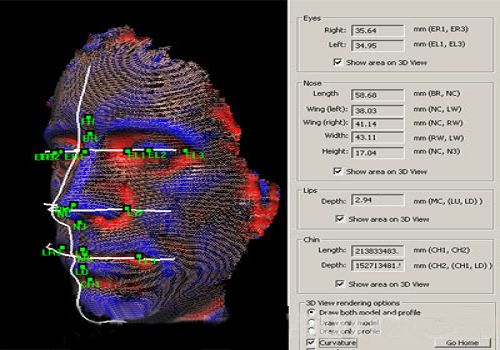 From 3D movies and TVs to 3D fingerprint attendance systems, the concept of 3D has gradually become part of our daily lives. Now, 3D technology is making its way into the field of facial recognition, raising questions about its potential and challenges. How far can this innovation go? Will it bring us a more secure future, or will it face obstacles along the way?
**3D Face Recognition in Practice**
When it comes to biometric access control, facial recognition offers a powerful alternative to traditional methods like fingerprint scanning. While fingerprint systems are commonly used for time and attendance, facial recognition provides an added layer of security by detecting fraud more effectively. The core idea behind 3D face recognition is to capture the unique geometric structure of a person’s face, which can then be stored in a database. When compared with a real-time "live" face, if the data is accurate, the system accepts the match.
One of the key advantages of 3D face recognition is its speed and accuracy, along with non-contact identification—making it ideal for access control systems. However, despite these benefits, research on integrating 3D face recognition into practical applications is still in early stages. Capturing and storing 3D templates is more complex than 2D methods, and while it may not be as cost-effective as some other biometric technologies, it remains a promising area for future development.
Industry experts believe that 3D recognition can enable one-on-one access control, especially when combined with surveillance systems for forensic purposes. This could significantly enhance security in high-risk environments.
**The Future of 3D Facial Recognition**
In the realm of fingerprinting, the introduction of 3D technology allows for deeper, more accurate recognition, capturing details from the skin's surface down to the subcutaneous layers. This enhances both the efficiency and security of the system.
For facial recognition, the focus is on capturing a 3D image of the face and storing its geometric features in a database. When a real person is scanned, the system compares the 3D data across the entire face, reducing the chances of false positives. Although 3D verification might be slightly slower than some standard facial recognition systems, the one-to-one comparison improves overall accuracy, leading to more reliable results.
In essence, 3D technology brings a more comprehensive and detailed approach to facial recognition. But the big question remains: can it truly deliver a seamless experience in real-world applications? As the technology evolves, we’ll have to wait and see if 3D face recognition lives up to its potential.
From 3D movies and TVs to 3D fingerprint attendance systems, the concept of 3D has gradually become part of our daily lives. Now, 3D technology is making its way into the field of facial recognition, raising questions about its potential and challenges. How far can this innovation go? Will it bring us a more secure future, or will it face obstacles along the way?
**3D Face Recognition in Practice**
When it comes to biometric access control, facial recognition offers a powerful alternative to traditional methods like fingerprint scanning. While fingerprint systems are commonly used for time and attendance, facial recognition provides an added layer of security by detecting fraud more effectively. The core idea behind 3D face recognition is to capture the unique geometric structure of a person’s face, which can then be stored in a database. When compared with a real-time "live" face, if the data is accurate, the system accepts the match.
One of the key advantages of 3D face recognition is its speed and accuracy, along with non-contact identification—making it ideal for access control systems. However, despite these benefits, research on integrating 3D face recognition into practical applications is still in early stages. Capturing and storing 3D templates is more complex than 2D methods, and while it may not be as cost-effective as some other biometric technologies, it remains a promising area for future development.
Industry experts believe that 3D recognition can enable one-on-one access control, especially when combined with surveillance systems for forensic purposes. This could significantly enhance security in high-risk environments.
**The Future of 3D Facial Recognition**
In the realm of fingerprinting, the introduction of 3D technology allows for deeper, more accurate recognition, capturing details from the skin's surface down to the subcutaneous layers. This enhances both the efficiency and security of the system.
For facial recognition, the focus is on capturing a 3D image of the face and storing its geometric features in a database. When a real person is scanned, the system compares the 3D data across the entire face, reducing the chances of false positives. Although 3D verification might be slightly slower than some standard facial recognition systems, the one-to-one comparison improves overall accuracy, leading to more reliable results.
In essence, 3D technology brings a more comprehensive and detailed approach to facial recognition. But the big question remains: can it truly deliver a seamless experience in real-world applications? As the technology evolves, we’ll have to wait and see if 3D face recognition lives up to its potential.Hammer Drill Chisel Bit,Masonry Chisel Point Bit,Chisel Hammer Drill Bit,Sds Drill Bit Chisel
Danyang Yongshun Tools Co.,Ltd , https://www.china-drill-bit.com